Posts Tagged ‘effective meetings’
Meetings go long; attendees stealthily text under the table like no one can see them; one person talks the whole time, while everyone else rolls their eyes. All the while, the facilitator does nothing.
Sound familiar?
The amount of time wasted in unproductive meetings and the degree of frustration meeting participants feel is astronomical.
The solution is simple but may not feel easy.
Set clear meeting expectations at the beginning of EVERY meeting and hold people accountable when they violate the guidelines.
Most meeting facilitators don’t set expectations at the beginning of meetings. Instead, facilitators expect attendees to follow the unstated, assumed guidelines. And when the meeting facilitator’s boss, peers, or customers are on their phone, it’s too hard to say something, so facilitators ignore the behavior, hoping it will stop without intervention.
The key to getting what you want in meetings (and in life) is to ask, which for the most part, we don’t. We assume people will do things as we do.
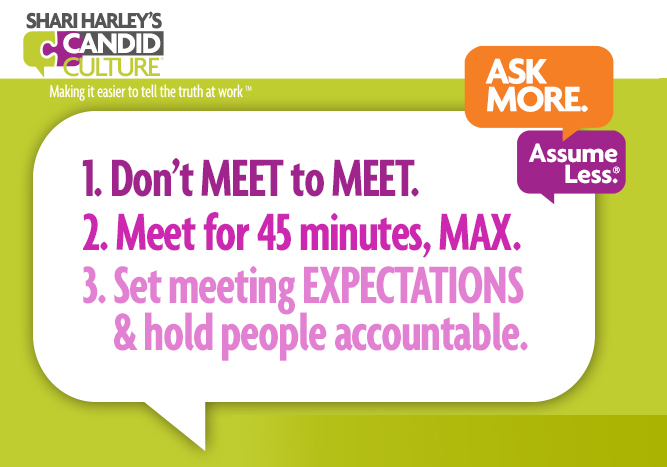
Tips for Running an Effective Meeting:
1. Set meeting expectations at your next meeting.
2. Write the expectations on a flip chart or in the chat and hang them up/post them in the chat at the beginning of every meeting.
3. Review the meeting expectations every time you meet, even with groups who meet weekly.
4. Ask meeting participants’ permission to manage meeting behavior. Your role as the meeting facilitator gives you the right to address bad meeting behavior. Asking for permission and letting people know you will say something if you see their phone etc., makes it easier to speak up.
5. Tell participants they are expected to hold themselves and each other accountable.
6. Then hold people accountable for following the meeting expectations. If you ask people not to side talk, address side talking when you hear it. If you ask people not to be on their laptops or phones, ask people to put them away. If one person talks too long, interrupt them. You will have no credibility if you set expectations but don’t hold people accountable.
The reason facilitators don’t hold people accountable is that they feel uncomfortable. It’s hard to tell your peers, boss, and coworkers to be more succinct. It’s almost impossible if you don’t set expectations about meeting behavior and set the expectation that you will say something when the meeting expectations are violated. The simple act of setting meeting expectations and asking people’s permission to manage to those expectations makes managing ‘bad’ meeting behavior easier. Not easy, but easier.
You may be thinking, “I don’t run these meetings. I’m an innocent victim.”
As a meeting participant, it is frustrating to go to poorly run meetings. But it’s also your role to speak up when you see things going poorly. Talk with the meeting facilitator.
The conversation could go something like this:
Express empathy: “That Wednesday team meeting is tough. I wouldn’t want to run it.”
Ask permission to give feedback: “I’d like to help. I’ve got a few observations and suggestions. Is it ok if I share them?”
Give feedback: “I’ve noticed that several people have been missing the meeting and others are on their phones and laptops during meetings. This definitely limits what we can get done and must be frustrating to you. What are your thoughts?”
Make a suggestion: “What do you think of setting meeting expectations at the next meeting and then telling people you’re going to hold them accountable?”
Offer help: “You’re not alone in this meeting. I’d be happy to tee up this discussion and explain why we need to set meeting expectations. What do you think?”
The facilitator knows the meetings aren’t going well. She just doesn’t know what to do. Offer to help. Don’t judge. She might be more receptive than you think. And you can stop suffering through poorly run meetings.

Hybrid meetings are more complicated and more difficult to run. There are lots of pitfalls. But with advanced planning and preparation, hybrid meetings can be well run and efficient.
Hybrid meetings defined: Some participants are together in-person, other participants attend from different locations.
Some pitfalls of hybrid meetings:
- Can the people attending virtually hear people who are attending in-person, from a conference room?
- Are the people in the conference room ‘talking’ to each other with their eyes while the virtual attendees assume they’re ‘talking’ about them?
- Are people participating equally, regardless of their location (not unique to hybrid meetings)?
- Are people texting each other about their real thoughts versus saying them out loud (also not unique to hybrid meetings)?
- Did the facilitator provide hard copies of documents to in-person attendees and forget to send documents to virtual attendees?
The keys to running effective hybrid meetings – anticipate and practice before the meetings.

Do a dry run of a hybrid meeting before you run one. I run a practice session for all hybrid trainings I facilitate, even with repeat clients and multiple sessions with the same client. It’s not worth leaving anything to chance. Have two people in a conference room and another person attend virtually. Test the sound. Move around the conference room; sit in different locations. Can the virtual attendee see and hear, regardless of where in-person attendees are sitting?
Assess if you need an external camera and microphone. Getting these items set up may feel intimidating at first, but you only need to do it once. Once the technology is set up, it’s ready to use for future meetings.
Most conference rooms – even small ones – will need an external microphone so in-person participants can be heard by virtual participants. Trust me. I’ve learned this the hard way. The microphone in your laptop won’t pick up sufficient sound for virtual attendees to hear in-person attendees. You can buy a microphone for $30 at Best Buy or Amazon.
Plan how you will elicit balanced participation from attendees in all locations. Will you call on people? Consider sharing facilitation of different topics, so people in multiple locations lead different parts of the meeting.
Set expectations for participation when meetings start – using the chat and raise-of-hands feature, microphones on or muted, no distractions, and no messaging fellow participants offline. Don’t assume people know or will follow the guidelines from past meetings. Set expectations at the beginning of every meeting, even recurrent meetings.
When breaking people into groups during hybrid meetings, it’s tempting to put people in groups based on location, putting the in-person people together and the virtual people together. This practice exacerbates proximity bias (a topic for a future blog). While it’s harder to group in-person and virtual attendees together, it is more equitable.
Cameras on or cameras off? Discuss, decide, and tell participants in advance so virtual attendees are prepared.
Talk about the pitfalls of hybrid meetings with all attendees. Tell people to avoid ‘talking’ with their eyes to fellow in-person participants. Avoid having a camera capture the side of your face while you watch a different screen. Use the blur-your-background feature in Zoom if your background is distracting.
The key to leading effective hybrid meetings? Anticipate potential breakdowns. Prepare in advance. Communicate expectations with participants. Debrief meetings after they end. Make necessary changes. Repeat.
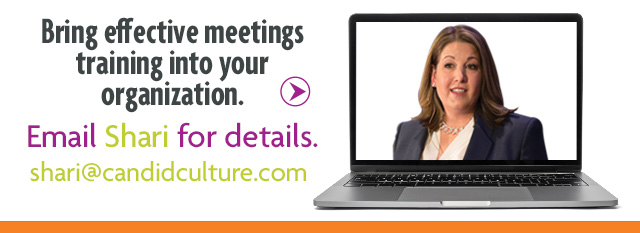
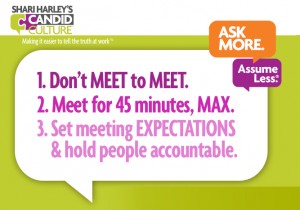 Meetings go long. Attendees stealthily text under the table like no one can see them. One person talks the whole time, while everyone else rolls their eyes. The decision maker isn’t there, forcing you to have another meeting. All the while, the facilitator does nothing.
Meetings go long. Attendees stealthily text under the table like no one can see them. One person talks the whole time, while everyone else rolls their eyes. The decision maker isn’t there, forcing you to have another meeting. All the while, the facilitator does nothing.
Sound familiar?
The amount of time wasted in unproductive meetings and the degree of frustration meeting participants feel is astronomical.
The solution is simple.
Set clear meeting expectations at the beginning of EVERY meeting and hold people accountable when they violate the guidelines.
Most meeting facilitators don’t set expectations at the beginning of meetings. Instead they expect attendees to follow the unstated, assumed guidelines. And when the meeting facilitators’ boss, peers or customers are on their phone, it’s too hard to say something. So facilitators ignore the behavior, hoping it will stop without intervention.
The key to getting what you want in meetings (and in life) is to ask, which for the most part, we don’t. We assume people will do things as we do.
Tips for Running a Good Meeting:
1. Set meeting expectations at your next meeting.
2. Write the expectations on a flip chart and hang them up at the beginning of every meeting. Or download our meeting expectations poster and hang it in your conference rooms.
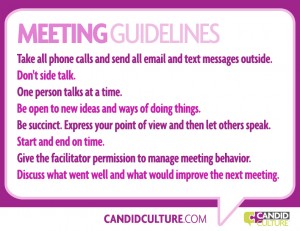
3. Review the meeting expectations every time you meet, even with groups who meet weekly.
4. Ask meeting participants’ permission to manage meeting behavior. Your role as the meeting facilitator gives you the right to address bad meeting behavior. Asking for permission and letting people know you will say something if you see their phone etc., makes it easier to speak up.
5. Tell participants they are expected to hold themselves and each other accountable.
6. Then hold people accountable for following the meeting expectations. If you ask people not to side talk, address side talking when you hear it. If you ask people not to be on their laptops or phones, ask people to put them away. If one person talks too long, interrupt him. You will have no credibility if you set expectations but don’t hold people accountable.
The reason facilitators don’t hold people accountable is that they feel uncomfortable. It’s hard to tell your peers, boss and other coworkers not to talk in circles. It’s almost impossible if you don’t set expectations about meeting behavior and set the expectation that you will say something when the meeting expectations are violated.
The simple act of setting meeting expectations and asking people’s permission to manage to those expectations makes doing so easier. Not easy, but easier. Asking your boss to put her phone away will never be easy, but it will be easier if you let her know BEFORE she pulls it out that you’ll do so.
You may be thinking, “I don’t run these meetings. I’m an innocent victim.”
As a meeting participant it is frustrating to go to poorly run meetings. But it’s also your role to speak up when you see things going poorly. Go to the meeting facilitator and give feedback. If you’re not sure what to say, follow The Feedback Formula outlined in my book How to Say Anything to Anyone.
Express empathy: “That Wednesday team meeting is tough. I wouldn’t want to run it.”
Ask permission to give feedback: “I’ve got a few observations and suggestions. Is it ok if I share them?”
Give feedback: “I’ve noticed that several people have been missing the meeting and others are on their phones and laptops during meetings. This definitely limits what we can get done and must be frustrating to you. What are your thoughts?”
Make a suggestion: “What do you think of setting meeting expectations at the next meeting and then telling people you’re going to hold them accountable?”
Offer help: “You’re not alone in this meeting. I’d be happy to tee up this discussion and explain why we need to set meeting expectations. What do you think?”
The facilitator knows the meetings aren’t going well. She just doesn’t know what to do. Offer to help. Don’t judge. She might be more receptive than you think. And you can stop suffering through poorly run meetings.
 Meetings start and end late. Attendees slyly send text messages under the table, like no one can see them. Decision makers are absent, requiring you to have another meeting. One person talks most of the time, while everyone else tunes out.
Meetings start and end late. Attendees slyly send text messages under the table, like no one can see them. Decision makers are absent, requiring you to have another meeting. One person talks most of the time, while everyone else tunes out.
The meeting facilitator wants to do something but feels like s/he can’t. How do you tell someone two levels above you to put away his phone and pay attention?
The majority of meetings are too long and a poor use of time.
You can impact the meetings in your organization, even if you don’t run them.
The bad meeting behavior mentioned above is predictable. It’s happening everywhere.
If you want your meetings to be different, ask for something different, before problems occur.
The reason your meeting facilitators feel as if they can’t tell their boss’s boss to show up and pay attention is because there has been no expectation set that it’s ok to do so. Meeting guidelines have not been established. And if they were established it was done long ago and the expectations were long forgotten.
Running an effective meeting requires courage AND an understanding that the meeting facilitator has permission and is expected to address people who break the rules. Even the most senior person in the room has given the facilitator permission to correct him. Without this permission, your facilitator can’t say anything, which is why s/he doesn’t.
How to have better meetings. Follow these meeting guidelines:
- Get meeting attendees’ agreement on the meeting guidelines.
- Give the meeting facilitator AND attendees permission to enforce the meeting guidelines.
- Take two minutes to set expectations before every meeting. Yes every meeting, even standing meetings. People forget. When you remind people of the rules, it’s easier to enforce them.
- Post the meeting guidelines in all of your conference and training rooms as reminders. Make the posters with large font that can be read from any seat in the room. We’ve made it easy for you with our Make Meetings Work Poster.
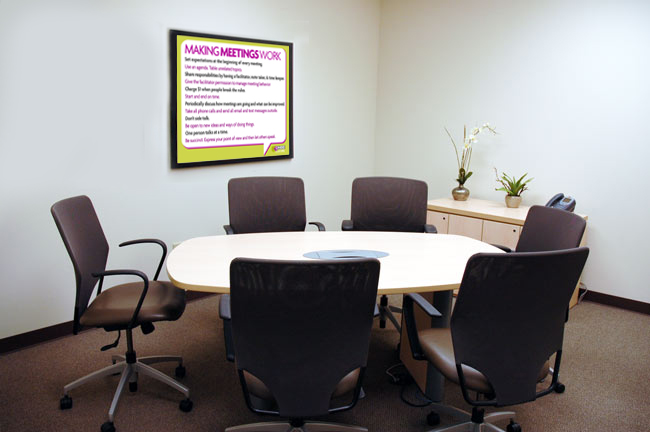
- Periodically discuss how meetings are going – what’s working and what can be improved. Create occasions and grant permission to give feedback. If it isn’t safe to tell the truth, nothing will get better.
Stop wasting your time in meetings. It’s never too late to set expectations. Hang them up on the wall for everyone to see. Anyone, at any level, and in any role can suggest setting and adhering to meeting guidelines. People in your organization want someone to take control. Maybe it will be you?






 Meetings go long. Attendees stealthily text under the table like no one can see them. One person talks the whole time, while everyone else rolls their eyes. The decision maker isn’t there, forcing you to have another meeting. All the while, the facilitator does nothing.
Meetings go long. Attendees stealthily text under the table like no one can see them. One person talks the whole time, while everyone else rolls their eyes. The decision maker isn’t there, forcing you to have another meeting. All the while, the facilitator does nothing.


